Pilgrimage
MEDIEVAL MONASTERY OF DRAGOVIĆ, REGION OF KNIN
Shrine Rising from the Water
It was originally built in 1395, on a river with the same name, as an important spiritual center of the Serbs in Northern Dalmatia. Later it was destroyed many times, moved, taken from the water, from thickets and evil people. After the blocking of the river Cetina near Vrlika in the early 1950s and the flooding of the valley called Little Šumadija, a new monastery was built on a hill by the new lake. The old one, however, remained underwater, straight, and waiting
Text and photo: Dragan Bosnić
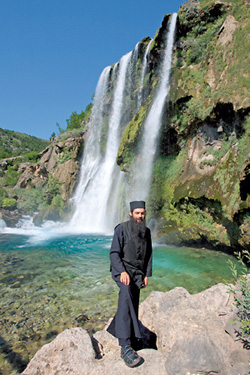 When one starts from Knin towards the south-east, down the road following the Dinara mountain, it is difficult not to notice the abundant spring of the Krka river. At the very beginning, it is enriched with water from the river of Krčić, falling from a twenty-meter high cliff. About twenty kilometers further, in the place where the Dinara and Kozjak narrows widens into a vast field, is the spring of the second karst beauty – the Cetina. Its seductive dance on the green field is cut by a dam and an about thirty kilometers long lake. When one starts from Knin towards the south-east, down the road following the Dinara mountain, it is difficult not to notice the abundant spring of the Krka river. At the very beginning, it is enriched with water from the river of Krčić, falling from a twenty-meter high cliff. About twenty kilometers further, in the place where the Dinara and Kozjak narrows widens into a vast field, is the spring of the second karst beauty – the Cetina. Its seductive dance on the green field is cut by a dam and an about thirty kilometers long lake.
Before the construction of the dam and flooding, the fertile valley of the Cetina was inhabited by Serbs, and the area used to be called Little Šumadija. The main road from Vrlika follows the right bank, and the left arm, more interesting for us, wriggles between Dinara and the lake. We pass bus stations which, for a long time, almost a decade and a half, have had neither buses nor passengers. Up towards the Dinara, there is a glimpse of villages, but not a single sparkle of life in them. In one settlement, closer and more accessible to the eye, one can see destroyed houses almost completely swallowed by the thicket. One rabbit, about twenty meters from the road, raises his ears only for a moment and disinterestedly continues his meal. Obviously, hunters also rarely come here.
There is a story saying that during the French-Austrian war in 1809, the inhabitants of these lands were fighting on the side of Austria. Disappointed, episcope Venedikt Knežević cursed them – may the earth swallow them, may God’s angel persecute them with his sword, may their children become orphans and wives widows, may their homes become desolated and hiding place for the beasts. It seems that the curse was fulfilled in the most horrible way. After a sharp turn, a deep bay appears with a height where remains of a city can be seen. Below Gradina, at the beginning of a steep bank, the monastery of Dragović at the moment stands peacefully. I say at the moment because Dragović had the craziest luck among the three monasteries of the Eparchy of Dalmatia.
MOVED THREE TIMES AND ALWAYS RETURNED
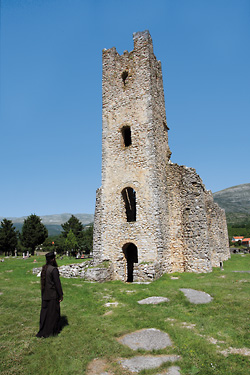 According to one legend, the monastery was named after Drago, who came from Bosnia to these lands with his brothers Vuk and Dobar. The bridge flooded by the lake was named after Vuk, and there is a village named Dobar in the vicinity of the monastery. It is more probable however that the monastery was named after a stream named Dragović, on which bank it was originally built. Many times this shrine was burnt down and three times it changed its location. According to prior Naum Milković, the Turks destroyed it because it was Serbian and Christian, the Venetians because it was not Roman and Catholic, and the Germans because it was Serbian. The monastery was first built in 1395, during the first migration of the Serbs to Dalmatia. Four years before the monastery of Dragović and only two years after the Battle of Kosovo, the Church of Holy Salvation in Cetina was built. According to one legend, the monastery was named after Drago, who came from Bosnia to these lands with his brothers Vuk and Dobar. The bridge flooded by the lake was named after Vuk, and there is a village named Dobar in the vicinity of the monastery. It is more probable however that the monastery was named after a stream named Dragović, on which bank it was originally built. Many times this shrine was burnt down and three times it changed its location. According to prior Naum Milković, the Turks destroyed it because it was Serbian and Christian, the Venetians because it was not Roman and Catholic, and the Germans because it was Serbian. The monastery was first built in 1395, during the first migration of the Serbs to Dalmatia. Four years before the monastery of Dragović and only two years after the Battle of Kosovo, the Church of Holy Salvation in Cetina was built.
After frequent plunders, the monastery community moved to the Eparchy of Buda, where they founded the monastery of Grabovac. Only in the late XVII century, thanks to Bishop Nikodim Busović, the monastery was revived again. For a while it was located at the Bribirska Glavica, and after the Karlovac Treaty in 1699, when the Turks were definitely left on the other side of Dinara, the reconstruction of the monastery began. As it was located in the immediate vicinity of a spring, humidity was destroying both the church and the monks. With the permission of the Venetian authorities, the church was moved to Vinogradi – a quarter of an hour towards the East. The new church was completed in 1860, and consecrated and dedicated to the Nativity of Virgin Mary seven years later.
The new church was not even a century old when time came for a new migration. The local poet Milica Bogovac wrote it like this:
In the thousand nine hundred
and fifty second year
people started talking
there will be a dam on Perća
and that it will flood our fields...
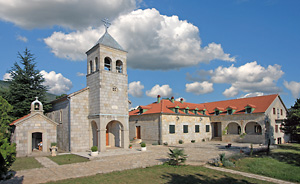 The dam was built and the water was up to the knees, sometimes much higher, in the village of Koljani. The fertile valley was flooded, as well as the monastery and river of Dragović, and the big Serbian population (about 5.000 souls) was moved, most of them to Srem. The whole monastic land was also flooded, so the newly erected church on the hill was supported from contributions of the decreasing number of faithful ones. The new church was built in 1958. Besides its northern side is the Chapel of St. Petka, also moved from the original location of the Monastery. The dam was built and the water was up to the knees, sometimes much higher, in the village of Koljani. The fertile valley was flooded, as well as the monastery and river of Dragović, and the big Serbian population (about 5.000 souls) was moved, most of them to Srem. The whole monastic land was also flooded, so the newly erected church on the hill was supported from contributions of the decreasing number of faithful ones. The new church was built in 1958. Besides its northern side is the Chapel of St. Petka, also moved from the original location of the Monastery.
Frequent destructions and plunders are the reasons why the monastery treasury today is not as rich as expected from such an old temple. The last year of the XVII century was especially dark, since the monastery was burnt and robbed six times. A part of St. George’s relics is kept in a small shrine. Besides valuable books, the treasury also includes a collection of antimises. The most valuable is the one which belonged to Patriarch Arsenije III Čarnojević (considered the first specimen printed from copper plate in Serbia). Also mentioned should be crosses in woodwork plated with filigree, cups, candlesticks, cressets... The icons of Christ and Virgin Mary with Christ from the iconostasis were silver plated in Venice.
DOUBLE BOTTOM OF CONSCIENCE
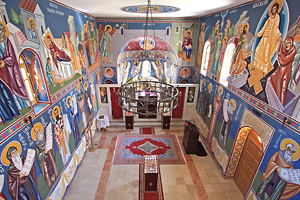 The last war in the Yugoslavian ruins brought new destruction and new depopulation. The church was desecrated in the summer of 1995 and turned into a barn, while the quarters were leveled with the ground. With the efforts of the Orthodox Episcope of Dalmatia Fotije and priest Djordje from Imotsko, the renewal of the monastery began in 2004. Nowadays, prior Versonufije and monk Jovan live in the monastery of Dragović, reconstructed and beautiful. Visitors seldom come. The reflection of the church can be seen in the calm water of the lake which did not bring any good to anyone. The supply of water was not fixed, the production of electricity was not significantly increased, however the old compact Serbian environment in the Cetina valley was forced to migrate and disappeared from there. What managed to run away from the dam and big waters later met storms, flares and merciful angels all together. The last war in the Yugoslavian ruins brought new destruction and new depopulation. The church was desecrated in the summer of 1995 and turned into a barn, while the quarters were leveled with the ground. With the efforts of the Orthodox Episcope of Dalmatia Fotije and priest Djordje from Imotsko, the renewal of the monastery began in 2004. Nowadays, prior Versonufije and monk Jovan live in the monastery of Dragović, reconstructed and beautiful. Visitors seldom come. The reflection of the church can be seen in the calm water of the lake which did not bring any good to anyone. The supply of water was not fixed, the production of electricity was not significantly increased, however the old compact Serbian environment in the Cetina valley was forced to migrate and disappeared from there. What managed to run away from the dam and big waters later met storms, flares and merciful angels all together.
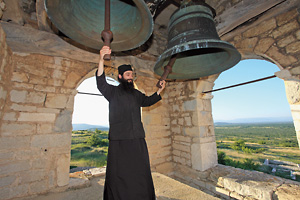 The crystal clear green water warmed by the August sun tempts swimmers. However, there aren’t any, nowhere. The Serbs are expelled and the Croats are afraid of the curse of the desecrated shrines, flooded houses, imprisoned graves. They say that sometimes, when the water level drops, the flooded temple dives out and with its washed walls reminds that evil is hard to hide. In the past, in the Turkish times, people say, the Catholics guarded the Orthodox shrines and the Orthodox people guarded the Catholic ones. The first tilters’ competition was held at the Dragović monastery estate. The Sinj tilters have kept the complete Serbian folk costume until the very day, and only adjusted the cap a bit. The original Serbian tilters’ costume is today also worn by the Guardians of Christ’s Grave. It is assumed that Serbs brought that custom from the Holy Land in the Middle Ages. This custom was preserved also in the period after World War II. At a time, the number of guardians fell to three, but it raised to 36 young men and their leader. The crystal clear green water warmed by the August sun tempts swimmers. However, there aren’t any, nowhere. The Serbs are expelled and the Croats are afraid of the curse of the desecrated shrines, flooded houses, imprisoned graves. They say that sometimes, when the water level drops, the flooded temple dives out and with its washed walls reminds that evil is hard to hide. In the past, in the Turkish times, people say, the Catholics guarded the Orthodox shrines and the Orthodox people guarded the Catholic ones. The first tilters’ competition was held at the Dragović monastery estate. The Sinj tilters have kept the complete Serbian folk costume until the very day, and only adjusted the cap a bit. The original Serbian tilters’ costume is today also worn by the Guardians of Christ’s Grave. It is assumed that Serbs brought that custom from the Holy Land in the Middle Ages. This custom was preserved also in the period after World War II. At a time, the number of guardians fell to three, but it raised to 36 young men and their leader. 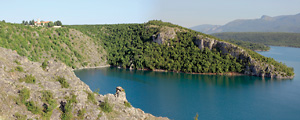 The Catholics in the nearby Vrlica have the same custom. The Catholics in the nearby Vrlica have the same custom.
During our return, we could not recognize a single street in Knin by its name. We walked the street of some Fra Mijo Kotaraš. Incautiously I commented out loud that it was probably some extreme character from history. Then they told me a story which sheds additional light on the flooded villages, expelled people, mass crimes, all storms and flashes. This Mijo indeed was extreme; however, he was born as a Serb in the village of Kotaraš near Knin. His rich father sent his clever son to an Orthodox monastery to learn. He once came to visit him and saw him with the sheep instead of a book. The rich man became very angry and moved his son to a Catholic monastery. There he did learn a lot. And transferred what he learned from generation to generation.
***
Deepness
”Who cut your eyes out, wretched man?!”
”My brother. My former brother.”
”Oh, so that is why the hole is so deep!”
***
Temple
”Early morning. I was told that the Croats from Vrlika had broken through the dam with a rocket two nights before. I paid no attention to this, hurriedly went outside and down to the lake to wash my face. A difficult day was in front of me, dangerous roads waiting. Dumbfound, I saw that the lake was almost halved and that I had to walk about thirty meters through the mud to get to the water. Then I raised my eyes towards the east and felt as if thunderstruck. Like in some mythical picture coming out of my own eye, brought from some immense distances, a temple was rising in the middle of the water. It had no roof, but the walls, still half in the water, stood straight, as well as the bell tower and part of the small dome with a cross. I felt I started to tremble, I closed my eyes, tears were rolling down my face. I managed to get a grip, I ran to the hill, looked for a camera, dug through the bags, through the house, the car, but could not find it.
An old man sat silently under a wild apple tree, smoking, watching the lake. Then he said:
– You do not need it, my son. Remember, this image can live only in us, not in machines. Only that way we can preserve it until the time comes to evaluate all this once again.” (B. M., notes from the war, 1992)
|
